 | –≠–ª–µ–∫—Ç—Ä–æ–Ω–Ω—ã–π –∫–æ–º–ø–æ–Ω–µ–Ω—Ç: UCC38085D | –°–∫–∞—á–∞—Ç—å:  PDF PDF  ZIP ZIP |
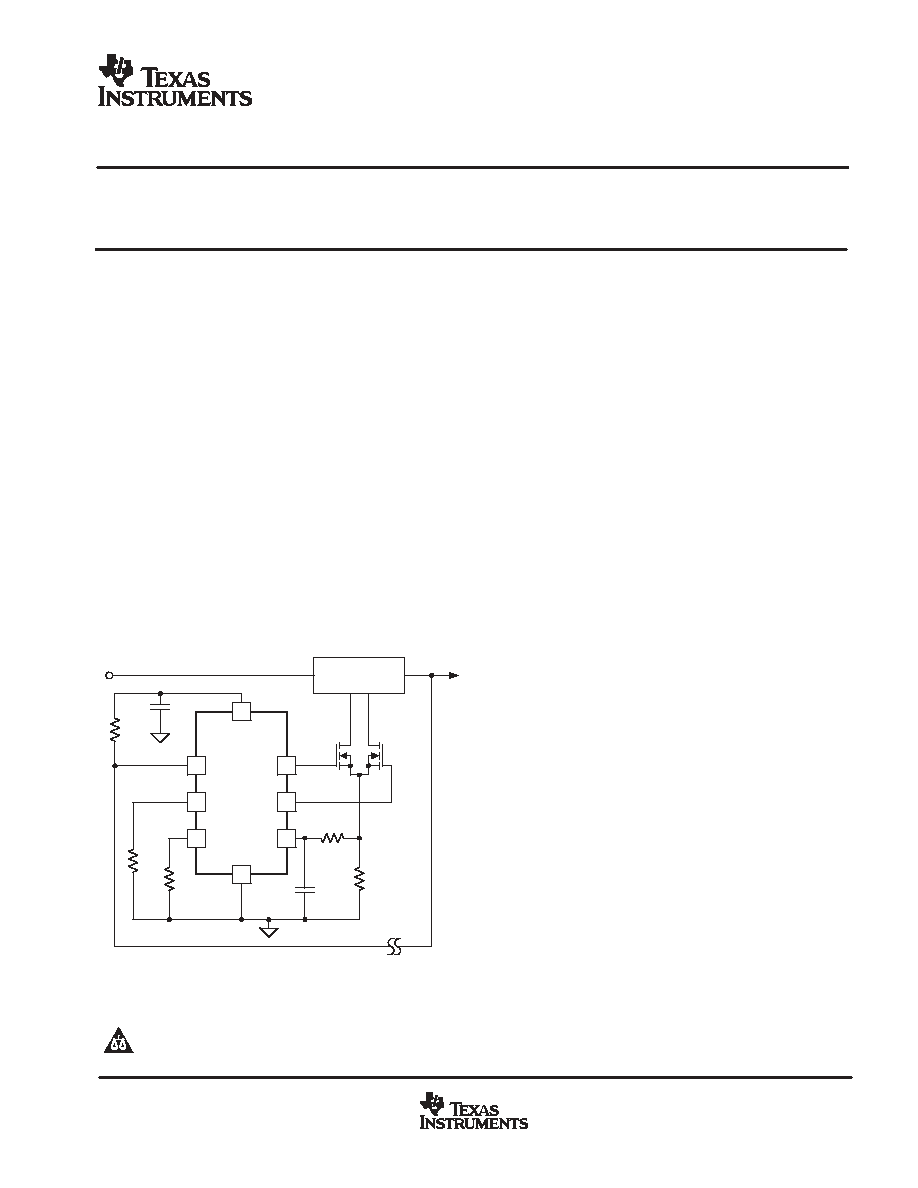
UCC28083, UCC28084, UCC28085, UCC28086
UCC38083, UCC38084, UCC38085, UCC38086
SLUS488B - SEPTEMBER 2002 - REVISED MAY 2003
8 PIN CURRENT MODE PUSH PULL PWM CONTROLLERS
WITH PROGRAMMABLE SLOPE COMPENSATION
1
www.ti.com
FEATURES
D
Programmable Slope Compensation
D
Internal Soft-Start on the UCC38083/4
D
Cycle-by-Cycle Current Limiting
D
Low Start-Up Current of 120
µ
A and 1.5 mA
Typical Run Current
D
Single External Component Oscillator
Programmable from 50 kHz to 1 MHz
D
High-Current Totem-Pole Dual Output Stage
Drives Push-Pull Configuration with 1-A Sink
and 0.5-A Source Capability
D
Current Sense Discharge Transistor to
Improve Dynamic Response
D
Internally Trimmed Bandgap Reference
D
Undervoltage Lockout with Hysteresis
APPLICATIONS
D
High-Efficiency Switch-Mode Power Supplies
D
Telecom dc-to-dc Converters
D
Point-of-Load or Point-of-Use Power Modules
D
Low-Cost Push-Pull and Half-Bridge
Applications
DESCRIPTION
The UCC38083/4/5/6 is a family of BiCMOS pulse width
modulation (PWM) controllers for dc-to-dc or off-line
fixed-frequency current-mode switching power
supplies. The dual output stages are configured for the
push-pull topology. Both outputs switch at half the
oscillator frequency using a toggle flip-flop. The dead
time between the two outputs is typically 110 ns, limiting
each output's duty cycle to less than 50%.
The new UCC3808x family is based on the UCC3808A
architecture. The major differences include the addition
of a programmable slope compensation ramp to the CS
signal and the removal of the error amplifier. The current
flowing out of the ISET pin through an external resistor
is monitored internally to set the magnitude of the slope
compensation function. This device also includes an
internal discharge transistor from the CS pin to ground,
which is activated at each clock cycle after the pulse is
terminated. This discharges any filter capacitance on
the CS pin during each cycle and helps minimize filter
capacitor values and current sense delay.
The UCC38083 and the UCC38084 devices have a
typical soft-start interval time of 3.5 ms while the
UCC38085 and the UCC38086 has less than 100
µ
s for
applications where internal soft-start is not desired.
The UCC38083 and the UCC38085 devices have the
turn-on/off thresholds of 12.5 V / 8.3 V, while the
UCC38084 and the UCC38086 has the turn-on/off
thresholds of 4.3 V / 4.1 V. Each device is offered in 8-pin
TSSOP (PW), 8-pin SOIC (D) and 8-pin PDIP (P)
packages.
PRODUCTION DATA information is current as of publication date.
Products conform to specifications per the terms of Texas Instruments
standard warranty. Production processing does not necessarily include
testing of all parameters.
Copyright
2002-2003, Texas Instruments Incorporated
Please be aware that an important notice concerning availability, standard warranty, and use in critical applications of Texas Instruments
semiconductor products and disclaimers thereto appears at the end of this data sheet.
UDG-01080
BASIC APPLICATION
OUTA
OUTB
CS
CTRL
RT
ISET
GND
VDD
RSET
RT
POWER
TRANSFORMER
CF
RF
RS
VIN
UCC3808x
FEEDBACK
VOUT

UCC28083, UCC28084, UCC28085, UCC28086
UCC38083, UCC38084, UCC38085, UCC38086
SLUS488B - SEPTEMBER 2002 - REVISED MAY 2003
2
www.ti.com
ORDERING INFORMATION
THERMAL RESISTANCE TABLE
PACKAGE
jc(
∞
C/W)
ja(
∞
C/W)
SOIC-8 (D)
42
84 to 160(1)
PDIP-8 (P)
50
110(1)
TSSOP-8 (PW)
32(2)
232 to 257(2)
NOTES: (1) Specified
ja (junction to ambient) is for devices mounted to 5-inch2 FR4 PC board
with one ounce copper where noted. When resistance range is given, lower values
are for 5 inch2 aluminum PC board. Test PWB was 0.062 inch thick and typically
used 0.635-mm trace widths for power packages and 1.3-mm trace widths for
non-power packages with a 100-mil x 100-mil probe land area at the end of each
trace.
(2). Modeled data. If value range given for
ja, lower value is for 3x3 inch. 1 oz internal
copper ground plane, higher value is for 1x1-inch. ground plane. All model data
assumes only one trace for each non-fused lead.
AVAILABLE OPTIONS
TA
INTERNAL
SOFT START
UVLO
PACKAGES
TA
INTERNAL
SOFT START
ON
OFF
SOIC-8 (D)
PDIP-8 (P)
TSSOP-8 (PW)
3.5 ms
12.5 V
8.3 V
UCC28083D
UCC28083P
UCC28083PW
-40
∞
C to 85
∞
C
3.5 ms
4.3 V
4.1 V
UCC28084D
UCC28084P
UCC28084PW
-40
∞
C to 85
∞
C
75
µ
s
12.5 V
8.3 V
UCC28085D
UCC28085P
UCC28085PW
75
µ
s
4.3 V
4.1 V
UCC28086D
UCC28086P
UCC28086PW
3.5 ms
12.5 V
8.3 V
UCC38083D
UCC38083P
UCC38083PW
0
∞
C to 70
∞
C
3.5 ms
4.3 V
4.1 V
UCC38084D
UCC38084P
UCC38084PW
0
∞
C to 70
∞
C
75
µ
s
12.5 V
8.3 V
UCC38085D
UCC38085P
UCC38085PW
75
µ
s
4.3 V
4.1 V
UCC38086D
UCC38086P
UCC38086PW
The D and PW packages are available taped and reeled. Add R suffix to device type, e.g. UCC28083DR (2500 devices
per reel) or UCC38083PWR (2000 devices per reel).
1
2
3
4
8
7
6
5
CTRL
ISET
CS
RT
VDD
OUTA
OUTB
GND
D OR P PACKAGE
(TOP VIEW)
1
2
3
4
8
7
6
5
PW PACKAGE
(TOP VIEW)
OUTB
GND
RT
CS
OUTA
VDD
CTRL
ISET

UCC28083, UCC28084, UCC28085, UCC28086
UCC38083, UCC38084, UCC38085, UCC38086
SLUS488B - SEPTEMBER 2002 - REVISED MAY 2003
3
www.ti.com
absolute maximum ratings over operating free-air temperature (unless otherwise noted)
Supply voltage, V
DD
(I
DD
< 10 mA)
15 V
. . . . . . . . . . . . . . . . . . . . . . . . . . . . . . . . . . . . . . . . . . . . . . . . . . . . . . . . . . . . .
Supply current, I
DD
20 mA
. . . . . . . . . . . . . . . . . . . . . . . . . . . . . . . . . . . . . . . . . . . . . . . . . . . . . . . . . . . . . . . . . . . . . . . . . .
Sink current (peak):
OUTA
1.0 A
. . . . . . . . . . . . . . . . . . . . . . . . . . . . . . . . . . . . . . . . . . . . . . . . . . . . . . . . . . . . . . . . .
OUTB
1.0 A
. . . . . . . . . . . . . . . . . . . . . . . . . . . . . . . . . . . . . . . . . . . . . . . . . . . . . . . . . . . . . . . . .
Source current (peak): OUTA
-0.5 A
. . . . . . . . . . . . . . . . . . . . . . . . . . . . . . . . . . . . . . . . . . . . . . . . . . . . . . . . . . . . . . . .
OUTB
-0.5 A
. . . . . . . . . . . . . . . . . . . . . . . . . . . . . . . . . . . . . . . . . . . . . . . . . . . . . . . . . . . . . . . .
Analog inputs:
CTRL
-0.3 V to V
DD
+0.3 V
. . . . . . . . . . . . . . . . . . . . . . . . . . . . . . . . . . . . . . . . . . . . . . . . . . .
CS
-0.3 V to V
DD
+0.3 V, not to exceed 6 V
. . . . . . . . . . . . . . . . . . . . . . . . . . . . . . . . . . . . .
R
SET
(minimum)
>5 k
. . . . . . . . . . . . . . . . . . . . . . . . . . . . . . . . . . . . . . . . . . . . . . . . . . . . . .
R
T
(-100
µ
A < I
RT
< 100
µ
A)
-0.3 V to 2.0 V
. . . . . . . . . . . . . . . . . . . . . . . . . . . . . . . . . . . . .
Power dissipation at T
A
= 25
∞
C (P package)
1 W
. . . . . . . . . . . . . . . . . . . . . . . . . . . . . . . . . . . . . . . . . . . . . . . . . . . . .
Power dissipation at T
A
= 25
∞
C (D package)
650 mW
. . . . . . . . . . . . . . . . . . . . . . . . . . . . . . . . . . . . . . . . . . . . . . . . .
Power dissipation at T
A
= 25
∞
C (PW package)
400 mW
. . . . . . . . . . . . . . . . . . . . . . . . . . . . . . . . . . . . . . . . . . . . . . .
Junction operating temperature, T
J
-55
∞
C to 150
∞
C
. . . . . . . . . . . . . . . . . . . . . . . . . . . . . . . . . . . . . . . . . . . . . . . . . . . .
Storage temperature, T
stg
-65
∞
C to 150
∞
C
. . . . . . . . . . . . . . . . . . . . . . . . . . . . . . . . . . . . . . . . . . . . . . . . . . . . . . . . . . . .
Lead temperature (soldering 10 seconds)
300
∞
C
. . . . . . . . . . . . . . . . . . . . . . . . . . . . . . . . . . . . . . . . . . . . . . . . . . . . . .
Stresses beyond those listed under "absolute maximum ratings" may cause permanent damage to the device. These are stress ratings only, and
functional operation of the device at these or any other conditions beyond those indicated under "recommended operating conditions" is not
implied. Exposure to absolute-maximum-rated conditions for extended periods may affect device reliability. All voltages are with respect to GND.
Currents are positive into, and negative out of the specified terminal.
electrical characteristics over recommended operating virtual junction temperature range,
V
DD
= 10 V (See Note 1),1-
µ
F capacitor from VDD to GND, R
T
= 165 k
, R
F
= 1 k
, C
F
= 220 pF,
R
SET
= 50 k
, T
A
= -40
∞
C to 85
∞
C for UCC2808x, T
A
= 0
∞
C to 70
∞
C for UCC3808x, T
A
= T
J
(unless otherwise noted)
overall
PARAMETER
TEST CONDITIONS
MIN
TYP
MAX
UNITS
Start-up current
VDD < UVLO start threshold voltage
120
200
µ
A
Supply current
CTRL = 0 V,
CS = 0 V,
See Note 1
1.5
2.5
mA
undervoltage lockout
PARAMETER
TEST CONDITIONS
MIN
TYP
MAX
UNITS
Start threshold voltage
UCC38083/5
See Note 1
11.5
12.5
13.5
Start threshold voltage
UCC38084/6
4.1
4.3
4.5
Minimum operating voltage
UCC38083/5
7.6
8.3
9.0
V
Minimum operating voltage
after start
UCC38084/6
3.9
4.1
4.3
V
Hysteresis voltage
UCC38083/5
3.5
4.2
5.1
Hysteresis voltage
UCC38084/6
0.1
0.2
0.3
oscillator
PARAMETER
TEST CONDITIONS
MIN
TYP
MAX
UNITS
Frequency
2 x f(OUTA)
180
200
220
kHz
Voltage amplitude
See Note 2
1.4
1.5
1.6
V
Oscillator fall time (dead time)
110
220
ns
RT pin voltage
1.2
1.5
1.6
V

UCC28083, UCC28084, UCC28085, UCC28086
UCC38083, UCC38084, UCC38085, UCC38086
SLUS488B - SEPTEMBER 2002 - REVISED MAY 2003
4
www.ti.com
electrical characteristics over recommended operating virtual junction temperature range,
V
DD
= 10 V (See Note 1),1-
µ
F capacitor from VDD to GND, R
T
= 165 k
, R
F
= 1 k
, C
F
= 220 pF,
R
SET
= 50 k
, T
A
= -40
∞
C to 85
∞
C for UCC2808x, T
A
= 0
∞
C to 70
∞
C for UCC3808x, T
A
= T
J
(unless otherwise noted)
current sense
PARAMETER
TEST CONDITIONS
MIN
TYP
MAX
UNITS
Gain
See Note 3
1.9
2.2
2.5
V/V
Maximum input signal voltage
CTRL = 5 V,
See Note 4
0.47
0.52
0.57
V
CS to output delay time
CTRL = 3.5 V,
0 mV
CS
600 mV
100
200
ns
Source current
-200
nA
Sink current
CS = 0.5 V,
RT = 2.0 V,
See Note 5
3
7
12
mA
Overcurrent threshold voltage
0.70
0.75
0.80
V
CTRL to CS offset voltage
CS = 0 V, 25
∞
C
0.55
0.70
0.90
V
CTRL to CS offset voltage
CS = 0 V
0.37
0.70
1.10
V
pulse width modulation
PARAMETER
TEST CONDITIONS
MIN
TYP
MAX
UNITS
Maximum duty cycle
Measured at OUTA or OUTB
48%
49%
50%
Minimum duty cycle
CTRL = 0 V
0%
output
PARAMETER
TEST CONDITIONS
MIN
TYP
MAX
UNITS
Low-level output voltage (OUTA or OUTB)
IOUT = 100 mA
0.5
1.0
V
High-level output voltage (OUTA or OUTB)
IOUT = -50 mA,
(VDD - VOUT), See Note 6
0.5
1.0
V
Rise time
CLOAD = 1 nF
25
60
ns
Fall time
CLOAD = 1 nF
25
60
ns
soft-start
PARAMETER
TEST CONDITIONS
MIN
TYP
MAX
UNITS
OUTA/OUTB soft-start interval time,
UCC38083/4
CTRL = 1.8 V,
CS = 0 V,
Duty cycle from 0 to full
1.3
3.5
8.5
ms
OUTA/OUTB soft-start interval time,
UCC38085/6
CTRL = 1.8 V,
CS = 0 V,
Duty cycle from 0 to full
30
75
110
µ
s
slope compensation
PARAMETER
TEST CONDITIONS
MIN
TYP
MAX
UNITS
IRAMP, peak
ISET, peak = 30
µ
A, Full duty cycle
125
150
175
µ
A
NOTE 1: For UCCx8083/5, set VDD above the start threshold before setting to 10 V.
NOTE 2: Measured at ISET pin.
NOTE 3: Gain is defined by A
+
D
V
CTRL
D
V
CS
, 0
VCS
0.4 V.
NOTE 4: Measured at trip point of latch with CS ramped from 0.4 V to 0.6 V.
NOTE 5: This internal current sink on the CS pin is designed to discharge and external filter capacitor. It is not intended to be a dc sink path.
NOTE 6: Not 100% production tested. Ensured by design and also by the rise time test.

UCC28083, UCC28084, UCC28085, UCC28086
UCC38083, UCC38084, UCC38085, UCC38086
SLUS488B - SEPTEMBER 2002 - REVISED MAY 2003
5
www.ti.com
functional block diagram
UDG-01081
Q
Q
T
+
8
2
3
4
7
6
5
1
CTRL
VDD
CS
ISET
GND
RT
OUTA
OUTB
0.75V
0.5V
1.5V
0.2V
S
Q
R
S
Q
R
0.5V
Vdd-1
VREF
S
Q
R
ISLOPE
Css
Iss
S
Q
R
Soft Start and Fault Latch
PWM Comparator/Latch
Output Driver
Oscillator
CS Circuitry
Slope Circuit
Bias/UVLO
ISLOPE =
5 x I SET
ICT
CT
1.5V
CT
80 k
60 k
0.3 V
Terminal Functions
TERMINAL
NAME
PACKAGE
I/O
DESCRIPTION
NAME
D OR P
I/O
DESCRIPTION
CS
3
I
The current-sense input to the PWM comparator, the cycle-by-cycle peak current comparator, and the
overcurrent comparator. The overcurrent comparator is only intended for fault sensing. Exceeding the
overcurrent threshold causes a soft-start cycle. An internal MOSFET discharges the current-sense filter
capacitor to improve dynamic performance of the power converter.
CTRL
1
I
Error voltage input to PWM comparator.
GND
5
-
Reference ground and power ground for all functions. Due to high currents, and high-frequency operation
of the IC, a low-impedance circuit board ground plane is highly recommended.
ISET
2
I
Current selection for slope compensation.
OUTA
7
O
Alternating high-current output stages.
OUTB
6
O
Alternating high-current output stages.
RT
4
I
Programs the oscillator.
VDD
8
I
Power input connection.
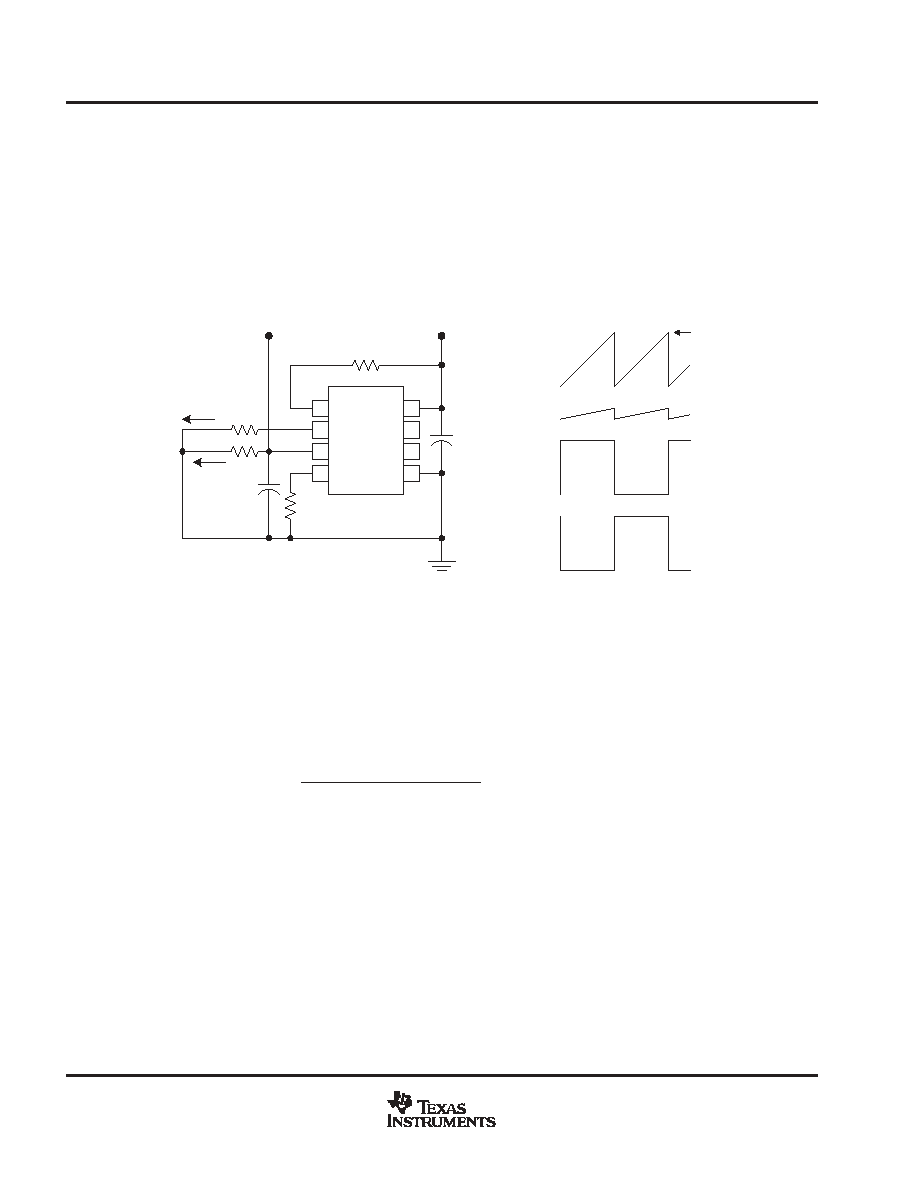
UCC28083, UCC28084, UCC28085, UCC28086
UCC38083, UCC38084, UCC38085, UCC38086
SLUS488B - SEPTEMBER 2002 - REVISED MAY 2003
6
www.ti.com
detailed pin descriptions
CTRL: The error voltage is typically generated by a secondary-side error amplifier and transmitted to the
primary-side referenced UCC3808x by means of an opto-coupler. CTRL has an internal divider ratio of 0.45 to
maintain a usable range with the minimum V
DD
of 4.1 V. The UCC38083/UCC38084 family features a built-in
full-cycle soft start while the UCC38085/6 does not.
For the UCC38083/4, soft-start is implemented as a clamp at the input to the PWM comparator. This causes
the output pulses to start near 0% duty cycle and increase until the clamp exceeds the CTRL voltage.
ISET: Program the slope compensation current ramp by connecting a resistor, RSET, from ISET to ground. The
voltage of the ISET pin tracks the 1.5-V internal oscillator ramp, as shown in Figure 1.
UCC38083
1
2
3
4
8
7
6
5
CTRL
VDD
ISET
CS
RT
OUTA
OUTB
GND
1uF
10k
RT
165k
220pF
RF
1k
RSET
V(CS)
VDD
I SET
I RAMP
ISET
IRAMP
OUTA
OUTB
I RAMP, peak = 5 x ISET, peak
Figure 1. Full Duty Cycle Output
The compensating current source, I
SLOPE
, at the CS pin is proportional to the ISET current, according to the
relation:
I
SLOPE
+
5
I
SET
The ramping current due to I
SLOPE
develops a voltage across the effective filter impedance that is normally
connected from the current sense resistor to the CS input. In order to program a desired compensating slope
with a specific peak compensating ramp voltage at the CS pin, use the RSET value in the following equation:
RSET
+
V
OSC(peak)
5
RF
RAMP VOLTAGE HEIGHT
Where V
OSC(peak)
+
1.5 V
Notice that the PWM Latch drives an internal MOSFET that will discharge an external filtering capacitor on the
CS pin. Thus, I
SLOPE
will appear to terminate when the PWM comparator or the cycle-by-cycle current limit
comparator sets the PWM latch. The actual compensating slope is not affected by premature termination of the
switching cycle.
(1)
(2)

UCC28083, UCC28084, UCC28085, UCC28086
UCC38083, UCC38084, UCC38085, UCC38086
SLUS488B - SEPTEMBER 2002 - REVISED MAY 2003
7
www.ti.com
detailed pin descriptions (continued)
OUTA and OUTB: Alternating high-current output stages. Both stages are capable of driving the gate of a power
MOSFET. Each stage is capable of 500-mA peak-source current, and 1-A peak-sink current.
The output stages switch at half the oscillator frequency, in a push-pull configuration. When the voltage on the
internal oscillator capacitor is rising, one of the two outputs is high, but during fall time, both outputs are off. This
dead time between the two outputs, along with a slower output rise time than fall time, ensures that the two
outputs cannot be on at the same time. This dead time is typically 110 ns.
The high-current output drivers consist of MOSFET output devices, which switch from VDD to GND. Each output
stage also provides a very low impedance to overshoot and undershoot. This means that in many cases,
external Schottky clamp diodes are not required.
RT: The oscillator programming pin. The oscillator features an internal timing capacitor. An external resistor,
R
T
, sets a current from the RT pin to ground. Due to variations in the internal C
T
, nominal V
RT
of 1.5 V can vary
from 1.2 V to 1.6 V
Selecting RT as shown programs the oscillator frequency:
RT
+
1
28.7
10
-12
1
f
OSC
*
2.0
10
-7
where f
OSC
is in Hz, resistance in
. The recommended range of timing resistors is between 25 k
and 698 k
.
For best performance, keep the timing resistor lead from the RT pin to GND (pin 5) as short as possible.
UDG-01083
Approximate Frequency
+
1
28.7
10
-12
R
T
)
2.0
10
-7
4
1.5 V
0.2 V
S
Q
R
I
RT
I
CT
C T
1.5 V
OSCILLATOR
OUTPUT
R
T
Figure 2. Block Diagram for Oscillator
VDD: The power input connection for this device. Although quiescent VDD current is very low, total supply
current may be higher, depending on OUTA and OUTB current, and the programmed oscillator frequency. Total
VDD current is the sum of quiescent VDD current and the average OUT current. Knowing the operating
frequency and the MOSFET gate charge (Q
G
), average OUT current can be calculated from:
I
OUT
+
Q
G
f
OSC
where f is the oscillator frequency.
To prevent noise problems, bypass VDD to GND with a ceramic capacitor as close to the chip as possible along
with an electrolytic capacitor. A 1-
µ
F decoupling capacitor is recommended.
(3)
(4)

UCC28083, UCC28084, UCC28085, UCC28086
UCC38083, UCC38084, UCC38085, UCC38086
SLUS488B - SEPTEMBER 2002 - REVISED MAY 2003
8
www.ti.com
APPLICATION INFORMATION
The following application circuit shows an isolated 12-V
IN
to 2.5 V
OUT
push-pull converter with scalable output
power (20 W to 200 W). Note that the pinout shown is for SOIC-8 and PDIP-8 packages.
typical application
UDG-01084
UCC3808x
7 OUTA
6 OUTB
3 CS
1
CTRL
4
RT
2
ISET
5
GND
8
VDD
RT
CF
220 pF
RS
6
3
1
4
2
5
165
k
TL431
4.7
4.7
1
µ
F
SR
DRIVE
VO = 2.2 V TO 3.3 V
ADJUSTABLE
VIN = 12 V
+/-20%V
RF 1 k
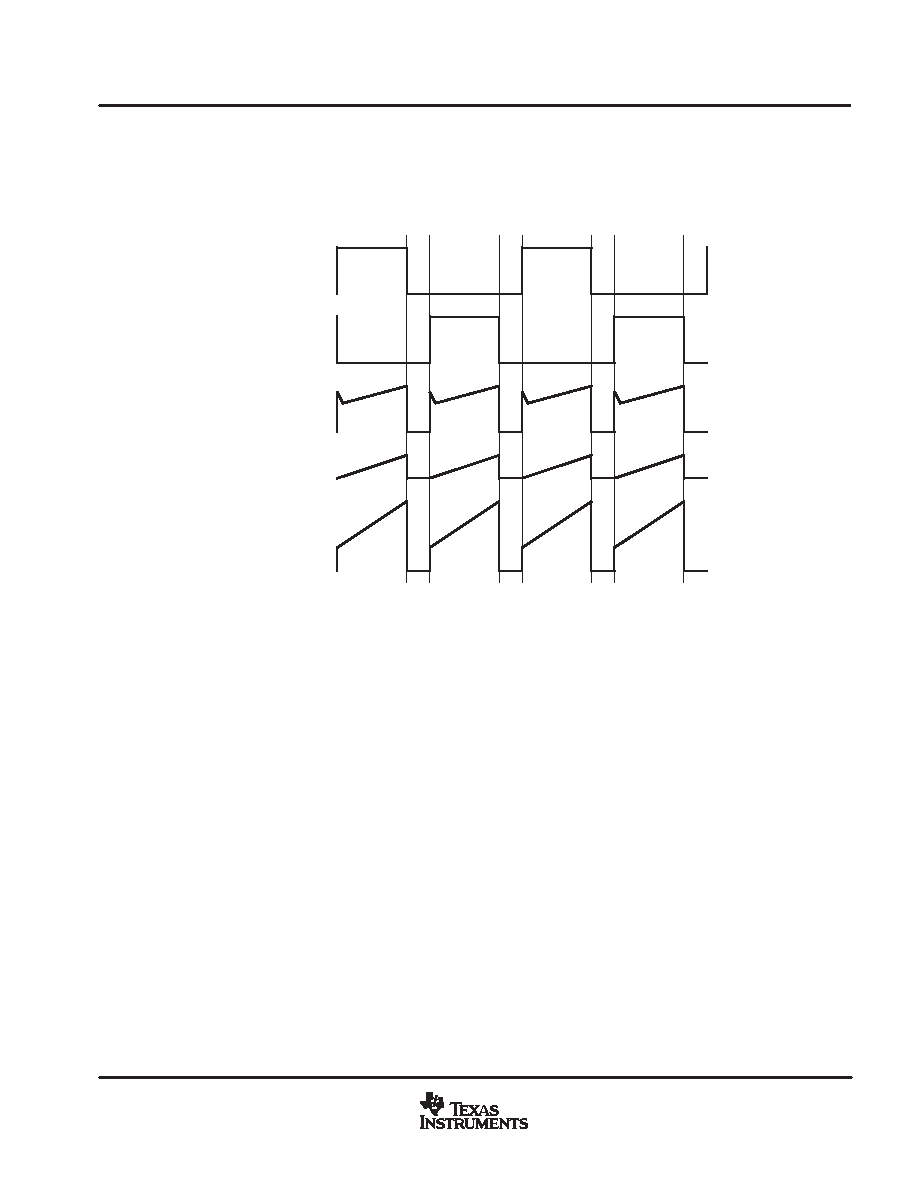
UCC28083, UCC28084, UCC28085, UCC28086
UCC38083, UCC38084, UCC38085, UCC38086
SLUS488B - SEPTEMBER 2002 - REVISED MAY 2003
9
www.ti.com
APPLICATION INFORMATION
operational waveforms
Figure 3 illustrates how the voltage ramp is effectively added to the voltage across the current sense element
V
CS
, to implement slope compensation.
UDG-01085
OUTA
OUTB
VRS
ADDED
RAMP
VOLTAGE
VCS, Pin 3
Figure 3. Typical Slope Compensation Waveforms at 80% Duty Cycle
In Figure 3, OUTA and OUTB are shown at a duty cycle of 80%, with the associated voltage VRS across the
current sense resistor of the primary push-pull power MOSFETs. The current flowing out of CS generates the
ramp voltage across the filter resistor R
F
that is positioned between the power current sense resistor and the
CS pin. This voltage is effectively added to VRS to provide slope compensation at VCS, pin 3. A capacitor C
F
is also recommended to filter the waveform at CS.
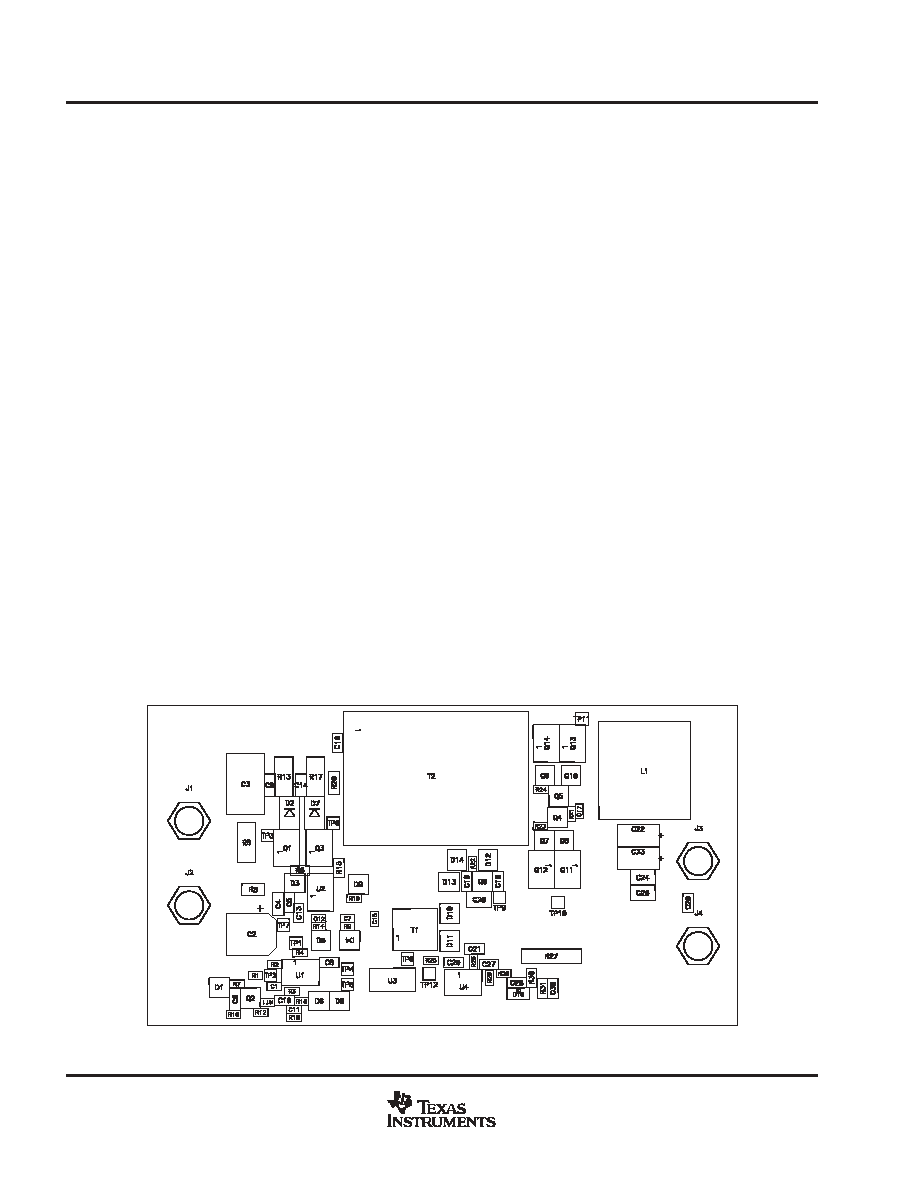
UCC28083, UCC28084, UCC28085, UCC28086
UCC38083, UCC38084, UCC38085, UCC38086
SLUS488B - SEPTEMBER 2002 - REVISED MAY 2003
10
www.ti.com
layout considerations
To prevent noise problems, bypass VDD to GND with a ceramic capacitor as close to the chip as possible along
with an electrolytic capacitor. A 1-
µ
F decoupling capacitor is recommended.
Use a local ground plane near the small signal pins (CTRL, ISET, CS and RT) of the IC for shielding. Connect
the local ground plane to the GND pin with a single trace. Do not extend the local ground plane under the power
pins (VDD, OUTA, OUTB and GND). Instead, use signal return traces to the GND pin for ground returns on the
side of the integrated circuit with the power pins.
For best performance, keep the timing resistor lead from RT pin (pin 4) to GND (pin 5) as short as possible.
special layout considerations for the TSSOP package
Due to the different pinout and smaller lead pitch of the TSSOP package, special attention must be paid to
minimize noise problems. The pinout is different because the device had to be rotated 90
∞
to fit into the smaller
TSSOP package.
For example, the two output pins are now on opposite sides of the package. The traces should not run under
the package together as they will couple switching noise into analog pins.
Another common problem is when RT and OUTB (pins 6 and 8) are routed together for some distance even
though they are not immediate side by side pins. Because of this, when OUTB rises, a voltage spike of upto
400 mV can couple into the RT. This spike causes the internal charge current into CT to be turned off
momentarily resulting in lower duty cycle. It is also important that note that the RT pin voltage cannot be
stabilized with a capacitor. The RT pin is just a dc voltage to program the internal CT. Instead, keep the OUTB
and RT runs short and far from each other and follow the printed wiring board layout suggestions above to fix
the problem.
reference design
A reference design is discussed in 50-W Push-Pull Converter Reference Design Using the UCC38083, TI
Literature Number SLUU135. This design controls a push-pull synchronous rectified topology with input range
of 18 V to 35 V (24 nominal) and 3.3-V output at 15 A. The schematic is shown in Figure 5 and the board layout
for the reference design is shown in Figure 4. Refer to the document for further details.
Figure 4. Reference Design Layout
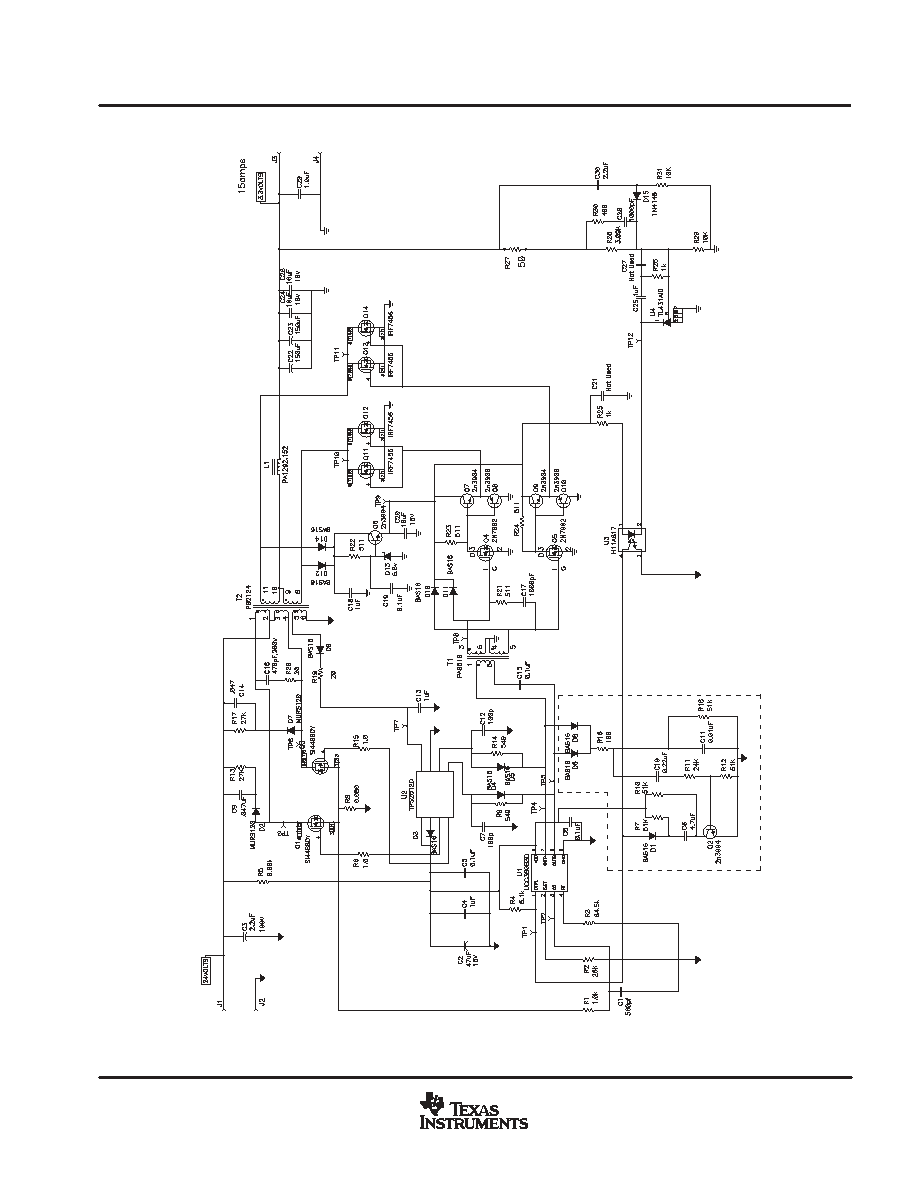
UCC28083, UCC28084, UCC28085, UCC28086
UCC38083, UCC38084, UCC38085, UCC38086
SLUS488B - SEPTEMBER 2002 - REVISED MAY 2003
11
www.ti.com
APPLICATION INFORMATION
Note
1. C28, R25, and D12 accelerate the control to the secondary side feedback at start-up and prevent output voltage overshoo
t.
Note 2. Components used for the UCC38085 only
.
+
3
GND
1
REG_IN
2
1IN
4
2IN
8
REG_OUT
6
VCC
5
2OUT
7
1OUT
+
+
See Note 2
Figure 5. Reference Design Schematic
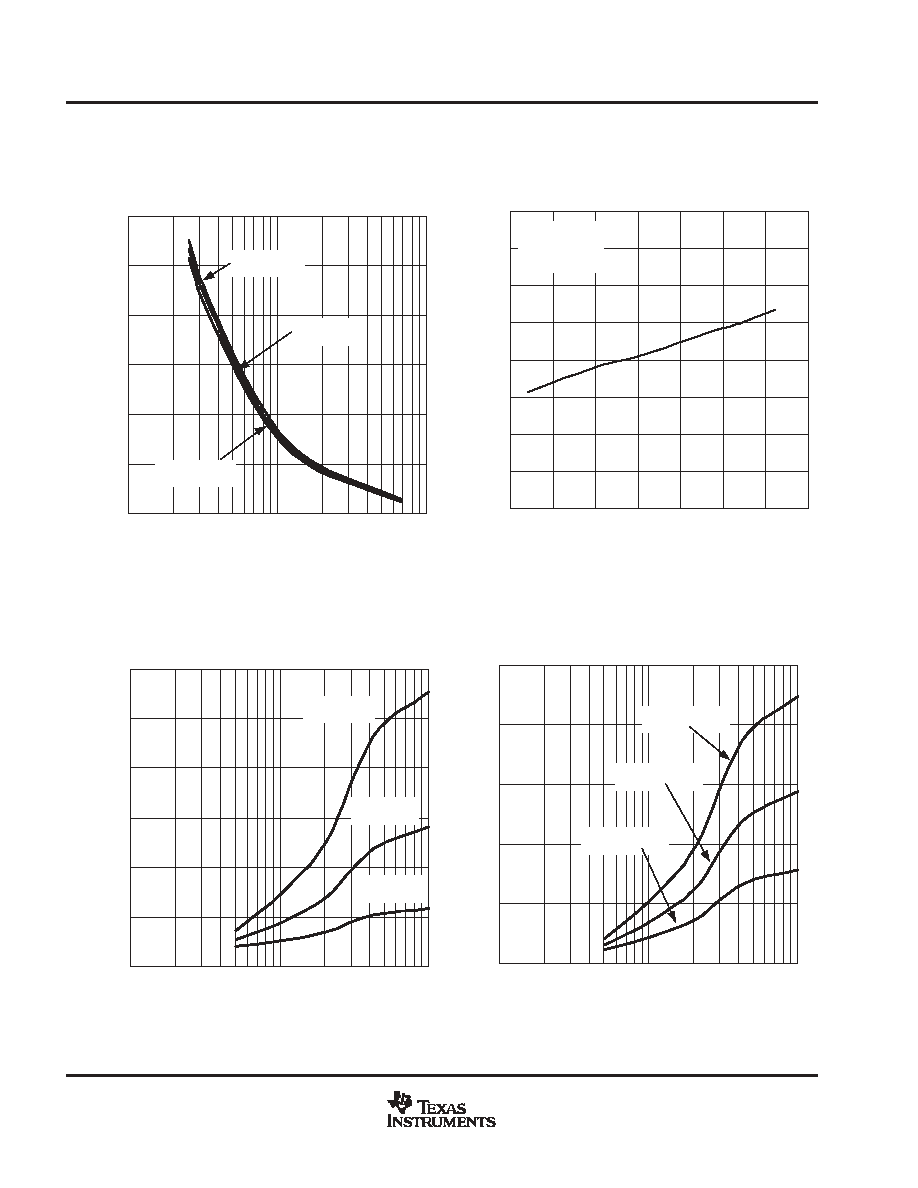
UCC28083, UCC28084, UCC28085, UCC28086
UCC38083, UCC38084, UCC38085, UCC38086
SLUS488B - SEPTEMBER 2002 - REVISED MAY 2003
12
www.ti.com
TYPICAL CHARACTERISTICS
Figure 6
10
100
1000
1200
1000
800
600
400
200
0
Frequency
-
k
H
z
OSCILLATOR FREQUENCY
vs
TIMING RESISTANCE
VDD = 15 V
VDD = 6 V
VDD = 10 V
T = 25
∞
C
T = 85
∞
C
T = 40
∞
C
RT - Timing Resistance - k
Figure 7
-50
50
125
Temperature -
220
215
205
200
195
185
180
-25
0
25
75
100
210
190
OSCILLATOR FREQUENCY
vs
TEMPERATURE
Frequency
-
k
H
z
∞
C
RT = 165 k
RF= 1 k
CF = 220 k
RSET = 50 k
Figure 8
10
1000
Frequency - kHz
12
10
8
6
4
2
0
100
IDD
vs
OSCILLATOR FREQUENCY, (NO LOAD)
IDD -
m
A
VDD = 14 V
VDD = 10 V
VDD = 6 V
Figure 9
10
1000
Frequency - kHz
25
20
15
10
5
0
100
IDD
vs
OSCILLATOR FREQUENCY, 1 nF LOAD
IDD -
m
A
VDD = 14 V
VDD = 10 V
VDD = 6 V

UCC28083, UCC28084, UCC28085, UCC28086
UCC38083, UCC38084, UCC38085, UCC38086
SLUS488B - SEPTEMBER 2002 - REVISED MAY 2003
13
www.ti.com
TYPICAL CHARACTERISTICS
10
1000
200
160
120
80
40
0
100
20
60
100
140
180
Figure 10
DEAD TIME
vs
TIMING RESISTANCE OVER VDD
Dead T
ime - ns
VDD = 14 V
T = -40
∞
C
T = 25
∞
C
VDD = 6 V*
VDD = 10 V
VDD = 6 V*
T = 85
∞
C
VDD = 14 V
RT - Timing Resistance - k
* UCCx8084/6, only
Figure 11
-50
125
Temperature -
160
100
60
40
0
50
20
80
120
140
-25
0
25
75
100
DEAD TIME
vs
TEMPERATURE
Dead T
ime - ns
∞
C
RT = 165 k
RF= 1 k
CF = 220 k
RSET = 50 k
Figure 12
-50
125
Temperature -
2.0
1.6
1.2
0.8
0.4
0.0
50
0.2
0.6
1.0
1.4
1.8
-25
0
25
75
100
CONTROL TO CS OFFSET
vs
TEMPERATURE
V
CTRL
- Control V
o
ltage - V
∞
C
VCS = 0.40 V
VCS = 0 V
Figure 13
0
15
VDD - Volts
0.6
0.5
0
10
0.1
0.2
0.3
0.4
(OC Clamped)
5
RAMP HEIGHT
vs
VDD
V
PK(cs)
- V
RSET = 18
TA = 25
∞
C
RSET = 10
RSET = 50
RSET = 100
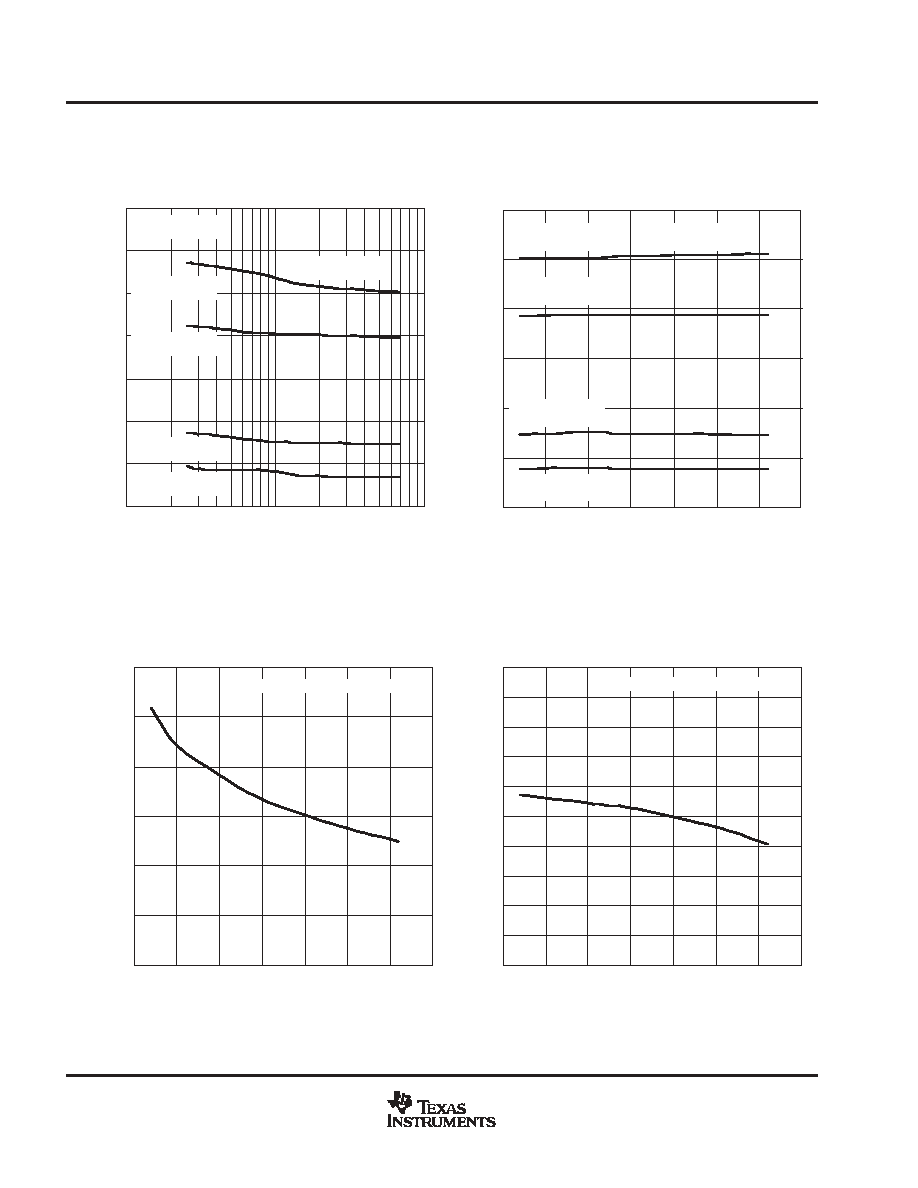
UCC28083, UCC28084, UCC28085, UCC28086
UCC38083, UCC38084, UCC38085, UCC38086
SLUS488B - SEPTEMBER 2002 - REVISED MAY 2003
14
www.ti.com
TYPICAL CHARACTERISTICS
Figure 14
10
1000
RT - k
0.7
0.6
0.4
0.3
0.1
0
100
0.2
0.5
(OC Clamped)
RAMP HEIGHT
vs
RT
V
PK(cs)
- V
RSET = 18
TA = 25
∞
C
RSET = 10
RSET = 50
RSET = 100
Figure 15
-50
125
Temperature -
0.6
0.5
0.1
0.0
25
0.2
0.3
0.4
(OC Clamped)
-25
0
50
75
100
RAMP HEIGHT
vs
TEMPERATURE
∞
C
V
PK(cs)
- V
RSET = 18
RSET = 10
RSET = 50
RSET = 100
Figure 16
-50
125
Temperature -
6
5
2
1
0
25
3
4
0
-25
50
75
100
SOFT START
vs
TEMPERATURE
Soft Start Internal - ms
∞
C
UCCx8083 AND UCCx8084
Figure 17
-50
125
Temperature -
100
90
80
70
60
50
25
55
65
75
85
95
50
75
100
0
-25
SOFT START
vs
TEMPERATURE
Soft Start Internal -
µ
s
∞
C
UCCx8085 AND UCCx8086

UCC28083, UCC28084, UCC28085, UCC28086
UCC38083, UCC38084, UCC38085, UCC38086
SLUS488B - SEPTEMBER 2002 - REVISED MAY 2003
15
www.ti.com
TYPICAL CHARACTERISTICS
Figure 18
-50
125
Temperature -
150
130
110
90
70
50
25
60
80
100
120
140
50
75
100
0
-25
∞
C
CS TO OUTX DELAY TIME
vs
TEMPERATURE
CS Prop Delay - ns
RELATED PRODUCTS
UCC3808, 8-Pin Low Power Current Mode Push-Pull PWM, (SLUS168)
UCC3808A, 8-Pin Low-Power Current-Mode Push-Pull PWM, (SLUS456)
UCC3806, Low Power, Dual Output, Current Mode PWM Controller, (SLUS272)
Table 1. 8-Pin Push-Pull PWM Controller Family Feature Comparison
Part Number
UVLO On
UVLO Off
CS
Discharge FET
Error
Amplifier
Programmable
Slope
Compensation
Internal
Softstart
UCC38083
12.5 V
8.3 V
Yes
No
Yes
Yes
UCC38084
4.3 V
4.1 V
Yes
No
Yes
Yes
UCC38085
12.5 V
8.3 V
Yes
No
Yes
No
UCC38086
4.3 V
4.1 V
Yes
No
Yes
No
UCC3808A-1
12.5 V
8.3 V
Yes
Yes
No
Yes
UCC3808A-2
4.3 V
4.1 V
Yes
Yes
No
Yes
UCC3808-1
12.5 V
8.3 V
No
Yes
No
Yes
UCC3808-2
4.3 V
4.1 V
No
Yes
No
Yes

UCC28083, UCC28084, UCC28085, UCC28086
UCC38083, UCC38084, UCC38085, UCC38086
SLUS488B - SEPTEMBER 2002 - REVISED MAY 2003
16
www.ti.com
MECHANICAL DATA
D (R-PDSO-G**)
PLASTIC SMALL-OUTLINE PACKAGE
8 PINS SHOWN
8
0.197
(5,00)
A MAX
A MIN
(4,80)
0.189
0.337
(8,55)
(8,75)
0.344
14
0.386
(9,80)
(10,00)
0.394
16
DIM
PINS **
4040047/E 09/01
0.069 (1,75) MAX
Seating Plane
0.004 (0,10)
0.010 (0,25)
0.010 (0,25)
0.016 (0,40)
0.044 (1,12)
0.244 (6,20)
0.228 (5,80)
0.020 (0,51)
0.014 (0,35)
1
4
8
5
0.150 (3,81)
0.157 (4,00)
0.008 (0,20) NOM
0
∞
- 8
∞
Gage Plane
A
0.004 (0,10)
0.010 (0,25)
0.050 (1,27)
NOTES: A. All linear dimensions are in inches (millimeters).
B. This drawing is subject to change without notice.
C. Body dimensions do not include mold flash or protrusion, not to exceed 0.006 (0,15).
D. Falls within JEDEC MS-012
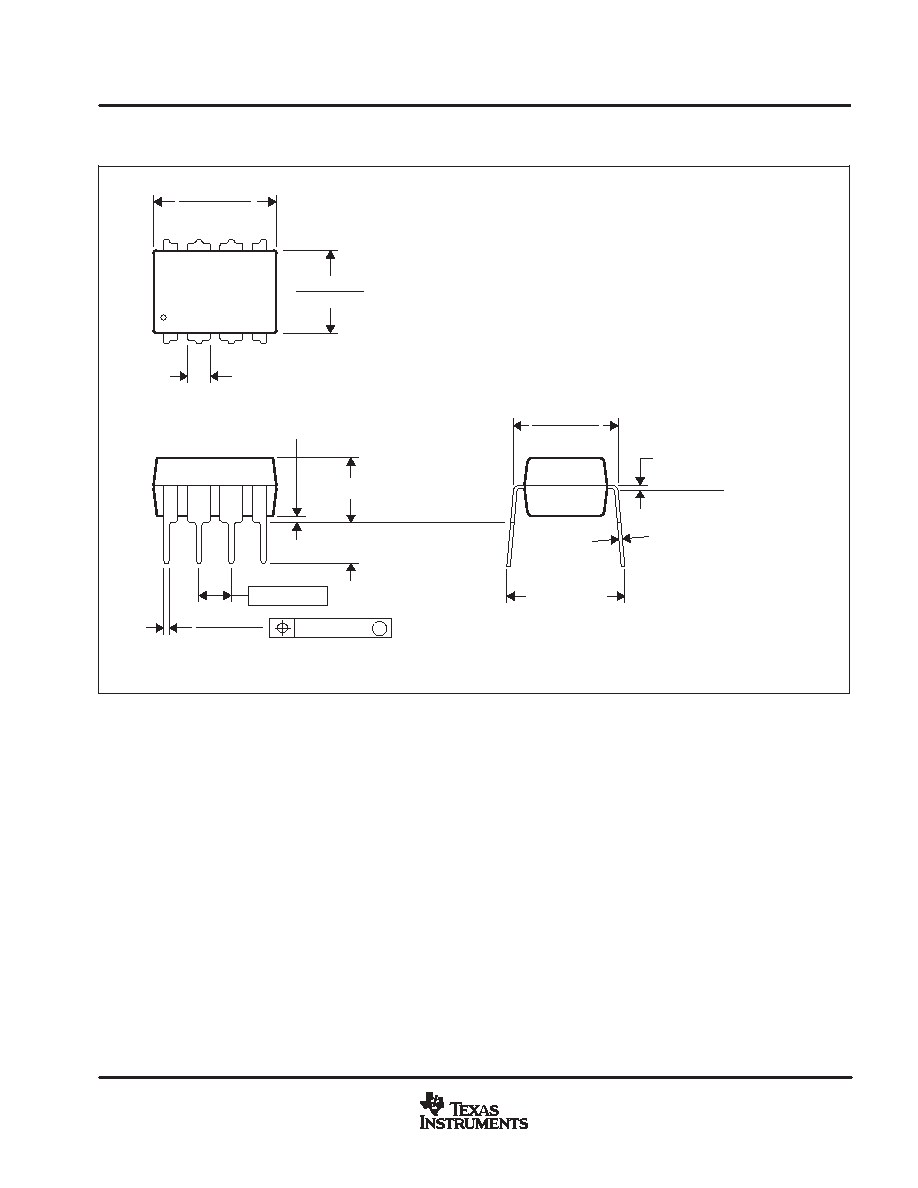
UCC28083, UCC28084, UCC28085, UCC28086
UCC38083, UCC38084, UCC38085, UCC38086
SLUS488B - SEPTEMBER 2002 - REVISED MAY 2003
17
www.ti.com
MECHANICAL DATA
P (PDIP)
PLASTIC DUAL-IN-LINE
8
4
0.015 (0,38)
Gage Plane
0.325 (8,26)
0.300 (7,62)
0.010 (0,25) NOM
MAX
0.430 (10,92)
4040082/D 05/98
0.200 (5,08) MAX
0.125 (3,18) MIN
5
0.355 (9,02)
0.020 (0,51) MIN
0.070 (1,78) MAX
0.240 (6,10)
0.260 (6,60)
0.400 (10,60)
1
0.015 (0,38)
0.021 (0,53)
Seating Plane
M
0.010 (0,25)
0.100 (2,54)
NOTES: A. All linear dimensions are in inches (millimeters).
B. This drawing is subject to change without notice.
C. Falls within JEDEC MS-001
For the latest package information, go to http://www.ti.com/sc/docs/package/pkg_info.htm
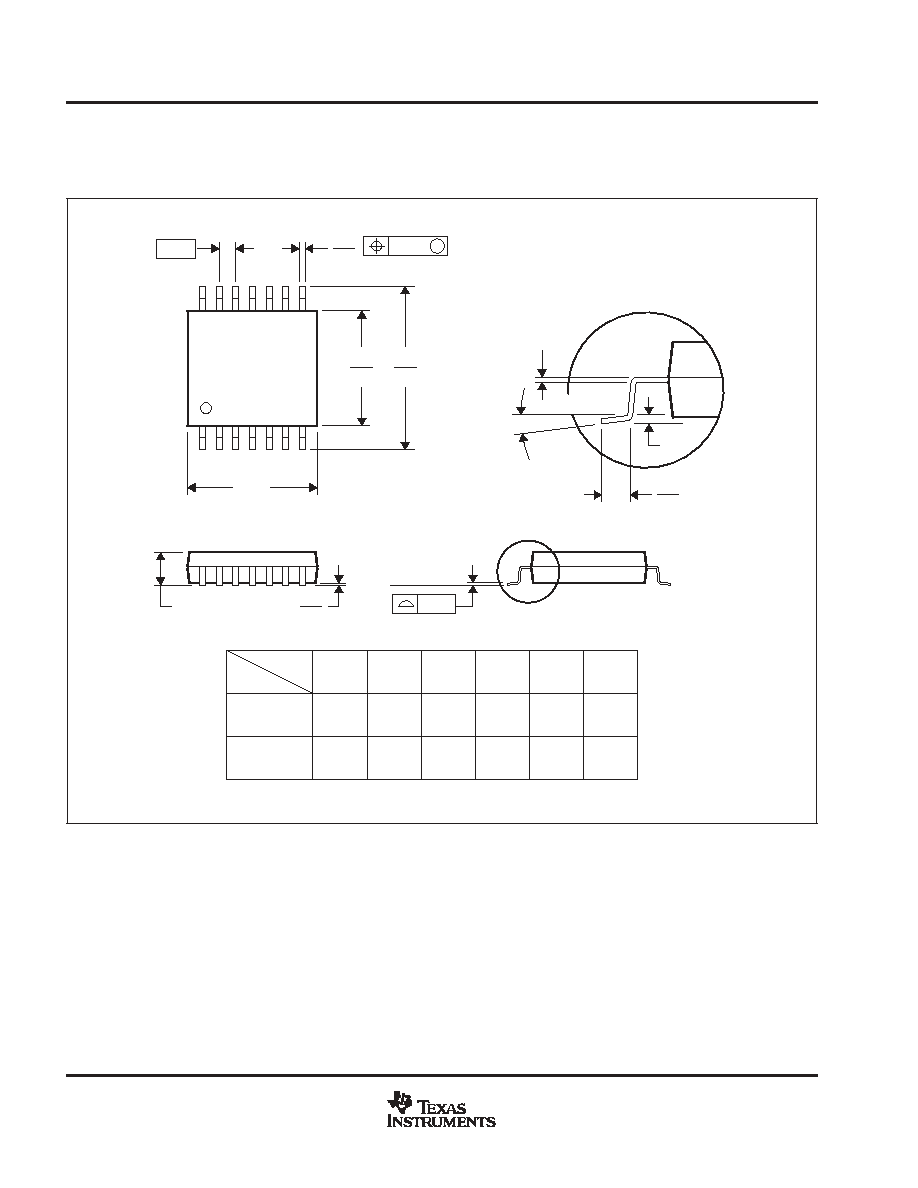
UCC28083, UCC28084, UCC28085, UCC28086
UCC38083, UCC38084, UCC38085, UCC38086
SLUS488B - SEPTEMBER 2002 - REVISED MAY 2003
18
www.ti.com
MECHANICAL DATA
PW (R-PDSO-G**)
PLASTIC SMALL-OUTLINE
PACKAGE
14 PINS SHOWN
0,65
M
0,10
0,10
0,25
0,50
0,75
0,15 NOM
Gage Plane
28
9,80
9,60
24
7,90
7,70
20
16
6,60
6,40
4040064/F 01/97
0,30
6,60
6,20
8
0,19
4,30
4,50
7
0,15
14
A
1
1,20 MAX
14
5,10
4,90
8
3,10
2,90
A MAX
A MIN
DIM
PINS **
0,05
4,90
5,10
Seating Plane
0
∞
- 8
∞
NOTES:A. All linear dimensions are in millimeters.
B. This drawing is subject to change without notice.
C. Body dimensions do not include mold flash or protrusion not to exceed 0,15.
D. Falls within JEDEC MO-153
For the latest package information, go to http://www.ti.com/sc/docs/package/pkg_info.htm

IMPORTANT NOTICE
Texas Instruments Incorporated and its subsidiaries (TI) reserve the right to make corrections, modifications,
enhancements, improvements, and other changes to its products and services at any time and to discontinue
any product or service without notice. Customers should obtain the latest relevant information before placing
orders and should verify that such information is current and complete. All products are sold subject to TI's terms
and conditions of sale supplied at the time of order acknowledgment.
TI warrants performance of its hardware products to the specifications applicable at the time of sale in
accordance with TI's standard warranty. Testing and other quality control techniques are used to the extent TI
deems necessary to support this warranty. Except where mandated by government requirements, testing of all
parameters of each product is not necessarily performed.
TI assumes no liability for applications assistance or customer product design. Customers are responsible for
their products and applications using TI components. To minimize the risks associated with customer products
and applications, customers should provide adequate design and operating safeguards.
TI does not warrant or represent that any license, either express or implied, is granted under any TI patent right,
copyright, mask work right, or other TI intellectual property right relating to any combination, machine, or process
in which TI products or services are used. Information published by TI regarding third-party products or services
does not constitute a license from TI to use such products or services or a warranty or endorsement thereof.
Use of such information may require a license from a third party under the patents or other intellectual property
of the third party, or a license from TI under the patents or other intellectual property of TI.
Reproduction of information in TI data books or data sheets is permissible only if reproduction is without
alteration and is accompanied by all associated warranties, conditions, limitations, and notices. Reproduction
of this information with alteration is an unfair and deceptive business practice. TI is not responsible or liable for
such altered documentation.
Resale of TI products or services with statements different from or beyond the parameters stated by TI for that
product or service voids all express and any implied warranties for the associated TI product or service and
is an unfair and deceptive business practice. TI is not responsible or liable for any such statements.
Following are URLs where you can obtain information on other Texas Instruments products and application
solutions:
Products
Applications
Amplifiers
amplifier.ti.com
Audio
www.ti.com/audio
Data Converters
dataconverter.ti.com
Automotive
www.ti.com/automotive
DSP
dsp.ti.com
Broadband
www.ti.com/broadband
Interface
interface.ti.com
Digital Control
www.ti.com/digitalcontrol
Logic
logic.ti.com
Military
www.ti.com/military
Power Mgmt
power.ti.com
Optical Networking
www.ti.com/opticalnetwork
Microcontrollers
microcontroller.ti.com
Security
www.ti.com/security
Telephony
www.ti.com/telephony
Video & Imaging
www.ti.com/video
Wireless
www.ti.com/wireless
Mailing Address:
Texas Instruments
Post Office Box 655303 Dallas, Texas 75265
Copyright
2003, Texas Instruments Incorporated


















